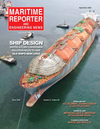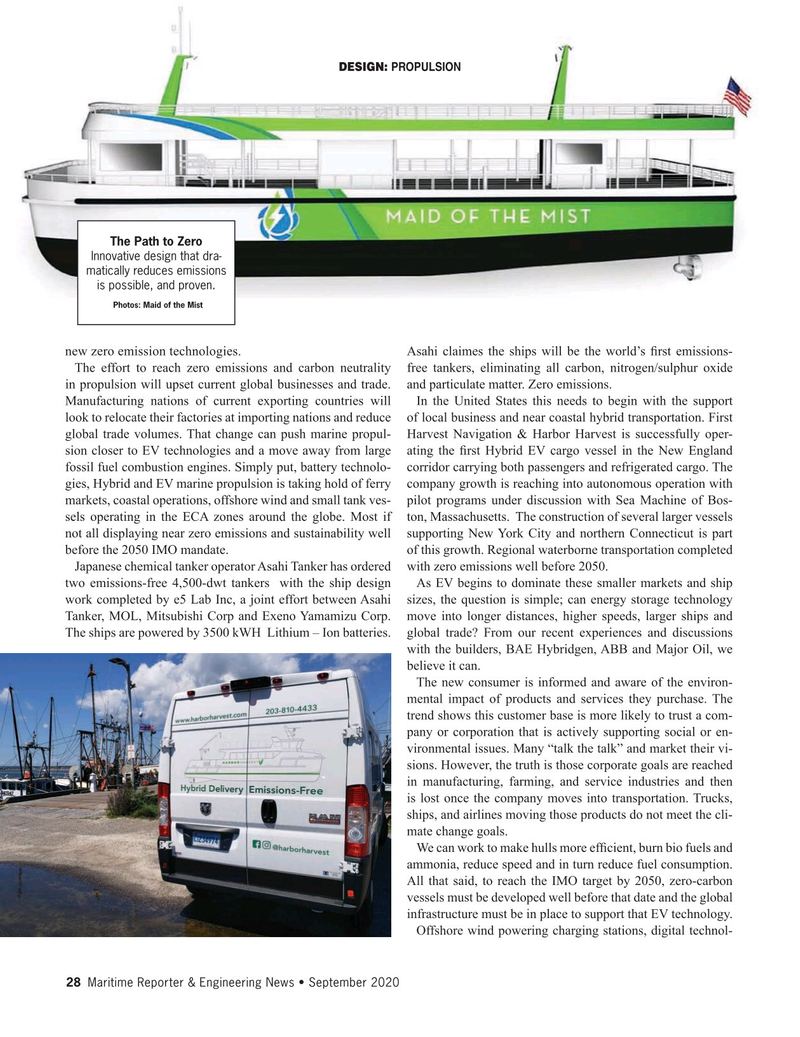
Page 28: of Maritime Reporter Magazine (September 2020)
Marine Design Annual
Read this page in Pdf, Flash or Html5 edition of September 2020 Maritime Reporter Magazine
DESIGN: PROPULSION
The Path to Zero
Innovative design that dra- matically reduces emissions is possible, and proven.
Photos: Maid of the Mist new zero emission technologies. Asahi claimes the ships will be the world’s ? rst emissions-
The effort to reach zero emissions and carbon neutrality free tankers, eliminating all carbon, nitrogen/sulphur oxide in propulsion will upset current global businesses and trade. and particulate matter. Zero emissions.
Manufacturing nations of current exporting countries will In the United States this needs to begin with the support look to relocate their factories at importing nations and reduce of local business and near coastal hybrid transportation. First global trade volumes. That change can push marine propul- Harvest Navigation & Harbor Harvest is successfully oper- sion closer to EV technologies and a move away from large ating the ? rst Hybrid EV cargo vessel in the New England fossil fuel combustion engines. Simply put, battery technolo- corridor carrying both passengers and refrigerated cargo. The gies, Hybrid and EV marine propulsion is taking hold of ferry company growth is reaching into autonomous operation with markets, coastal operations, offshore wind and small tank ves- pilot programs under discussion with Sea Machine of Bos- sels operating in the ECA zones around the globe. Most if ton, Massachusetts. The construction of several larger vessels not all displaying near zero emissions and sustainability well supporting New York City and northern Connecticut is part before the 2050 IMO mandate. of this growth. Regional waterborne transportation completed
Japanese chemical tanker operator Asahi Tanker has ordered with zero emissions well before 2050. two emissions-free 4,500-dwt tankers with the ship design As EV begins to dominate these smaller markets and ship work completed by e5 Lab Inc, a joint effort between Asahi sizes, the question is simple; can energy storage technology
Tanker, MOL, Mitsubishi Corp and Exeno Yamamizu Corp. move into longer distances, higher speeds, larger ships and
The ships are powered by 3500 kWH Lithium – Ion batteries. global trade? From our recent experiences and discussions with the builders, BAE Hybridgen, ABB and Major Oil, we believe it can.
The new consumer is informed and aware of the environ- mental impact of products and services they purchase. The trend shows this customer base is more likely to trust a com- pany or corporation that is actively supporting social or en- vironmental issues. Many “talk the talk” and market their vi- sions. However, the truth is those corporate goals are reached in manufacturing, farming, and service industries and then is lost once the company moves into transportation. Trucks, ships, and airlines moving those products do not meet the cli- mate change goals.
We can work to make hulls more ef? cient, burn bio fuels and ammonia, reduce speed and in turn reduce fuel consumption.
All that said, to reach the IMO target by 2050, zero-carbon vessels must be developed well before that date and the global infrastructure must be in place to support that EV technology.
Offshore wind powering charging stations, digital technol- 28 Maritime Reporter & Engineering News • September 2020
MR #9 (18-33).indd 28 9/9/2020 8:18:12 AM

 27
27

 29
29
